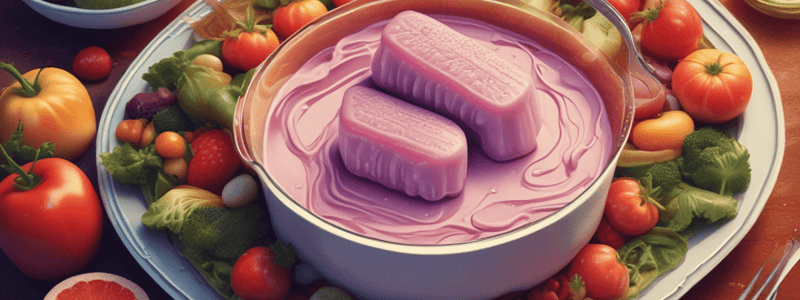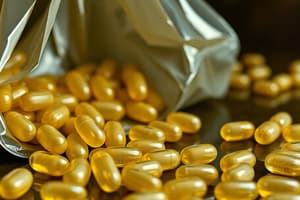Podcast
Questions and Answers
What is the primary purpose of degreasing halal bones in gelatin production?
What is the primary purpose of degreasing halal bones in gelatin production?
- To increase the yield of gelatin
- To enhance the flavor of gelatin
- To improve the texture of the final product
- To minimize cross-contamination from non-halal sources (correct)
Which treatment step involves the use of dedicated vats to ensure halal compliance?
Which treatment step involves the use of dedicated vats to ensure halal compliance?
- Lime Treatment
- Milling and Blending
- Acid Treatment (correct)
- Degreasing
In gelatin production, what is the significance of thorough cleaning before starting a halal run?
In gelatin production, what is the significance of thorough cleaning before starting a halal run?
- To eliminate non-halal materials from the equipment (correct)
- To reduce the cost of production
- To ensure compliance with health regulations
- To improve production efficiency
What role does milling play in the production of halal gelatin?
What role does milling play in the production of halal gelatin?
Why is proper packaging and labeling crucial in halal gelatin production?
Why is proper packaging and labeling crucial in halal gelatin production?
Which of the following can be used as alternatives to gelatin in food products?
Which of the following can be used as alternatives to gelatin in food products?
What is the purpose of blending different bloom strengths of gelatin?
What is the purpose of blending different bloom strengths of gelatin?
Which halal control point is necessary immediately after the extraction process?
Which halal control point is necessary immediately after the extraction process?
What is a critical consideration when selecting suppliers in halal gelatin production?
What is a critical consideration when selecting suppliers in halal gelatin production?
What is the significance of using dedicated setups for lime treatment?
What is the significance of using dedicated setups for lime treatment?
Which of the following is NOT a requirement for halal gelatin production?
Which of the following is NOT a requirement for halal gelatin production?
What is the primary purpose of assigning Halal Control Points in gelatin production?
What is the primary purpose of assigning Halal Control Points in gelatin production?
Which of the following steps in gelatin production is NOT a continuous process?
Which of the following steps in gelatin production is NOT a continuous process?
What is the significance of using dedicated equipment for halal gelatin production?
What is the significance of using dedicated equipment for halal gelatin production?
What is the primary role of Halal Control Points in gelatin production?
What is the primary role of Halal Control Points in gelatin production?
Flashcards are hidden until you start studying
Study Notes
Gelatin in Halal Food Production
- Gelatin is an animal by-product, partially hydrolyzed collagen tissue from various animal parts.
- Its halal status depends on the nature of raw materials used in its manufacture.
Types of Gelatin
- Type A gelatin: exclusively made from pork skins, HARAM in Islam.
- Type B gelatin: made from cattle and calf skins or demineralized cattle bones, SYUBHAH in Islam.
Alternative Sources of Gelatin
- Fish gelatin, but must not be from jalalah fish, is an alternative halal source.
Sources of Gelatin
- For gelatin from cattle skins, cattle bones, poultry skins, or other permitted animals to be halal, the animals must be slaughtered according to Islamic rites.
- Bones from halal species must be examined and segregated from those from non-halal species, which cannot be used.
- Bones from animals that have died without being properly slaughtered or that were used for religious ceremonies are prohibited.
Preparation of Source Material
- Bones: fresh bones from halal-slaughtered cattle are cleaned, degreased, dried, sorted, and crushed to a particle size of ca. 1 to 2 cm.
- Bones are then treated with dilute hydrochloric acid to remove mineral salts, resulting in sponge-like material called ossein.
- Hides: cattle hides from halal-slaughtered animals are received from the trimming operations of leather production.
- Hide pieces are dehaired chemically with a lime and sulfide solution, followed by mechanical loosening.
Production of Halal Gelatin
- Liming usually takes 8 to 12 weeks.
- The process is controlled by the degree of alkalinity of the lime as determined by titration with acid, or by making test extractions.
- Ossein requires more liming time than cattle hide.
- The material is then thoroughly washed with cold water to remove excess lime, its pH adjusted with acid, and it is extracted with hot water to recover the soluble gelatin.
- The number of extractions typically varies from three to six times.
- Extracts are kept separate, analyzed, and subsequently blended to meet various customer specifications.
Vegetable Substitutes for Gelatin
- Agar (also called agar-agar, gelose, Chinese isinglass, Japanese isinglass, Bengal isinglass, or Ceylon isinglass)
- Carrageenan (polysaccharide extracted from red seaweed)
- Pectin (polysaccharide substance present in cell walls of all plants)
- Xanthan gum (polysaccharide gum produced by bacteria fermentation, but the bacterial medium must be halal for the product to be halal)
- Arabic gum (a gum obtained from breaks or wounds in the bark of Acacia trees)
- Modified corn starch
- Cellulose gum
Halal Control Points in Halal Gelatin Production
- HCP1: Raw Materials - all sources (hides and bone chips) should be approved (halal animal & halal slaughtered) and constantly monitored.
- HCP2: Degreasing of Fresh Bones - ensure proper controls when degreasing the halal bone to minimize cross-contamination from non-halal sources.
- HCP3: Acid Treatment - use dedicated vats or pits for halal bones.
- HCP4: Lime Treatment - use dedicated setup for lime treatment.
- HCP5: Extraction, Evaporation, Extrusion, and Drying - ensure thorough cleaning and documentation before starting a halal run.
- HCP6: Milling and Blending - ensure proper cleaning of equipment to rid of any non-halal materials.
- HCP7: Packaging and Labeling - pack halal gelatin in clean containers and label properly with halal markings to avoid any mix-up with non-halal gelatin.
Gelatin in Halal Food Production
- Gelatin is an animal by-product, partially hydrolyzed collagen tissue from various animal parts.
- Its halal status depends on the nature of raw materials used in its manufacture.
Types of Gelatin
- Type A gelatin: exclusively made from pork skins, HARAM in Islam.
- Type B gelatin: made from cattle and calf skins or demineralized cattle bones, SYUBHAH in Islam.
Alternative Sources of Gelatin
- Fish gelatin, but must not be from jalalah fish, is an alternative halal source.
Sources of Gelatin
- For gelatin from cattle skins, cattle bones, poultry skins, or other permitted animals to be halal, the animals must be slaughtered according to Islamic rites.
- Bones from halal species must be examined and segregated from those from non-halal species, which cannot be used.
- Bones from animals that have died without being properly slaughtered or that were used for religious ceremonies are prohibited.
Preparation of Source Material
- Bones: fresh bones from halal-slaughtered cattle are cleaned, degreased, dried, sorted, and crushed to a particle size of ca. 1 to 2 cm.
- Bones are then treated with dilute hydrochloric acid to remove mineral salts, resulting in sponge-like material called ossein.
- Hides: cattle hides from halal-slaughtered animals are received from the trimming operations of leather production.
- Hide pieces are dehaired chemically with a lime and sulfide solution, followed by mechanical loosening.
Production of Halal Gelatin
- Liming usually takes 8 to 12 weeks.
- The process is controlled by the degree of alkalinity of the lime as determined by titration with acid, or by making test extractions.
- Ossein requires more liming time than cattle hide.
- The material is then thoroughly washed with cold water to remove excess lime, its pH adjusted with acid, and it is extracted with hot water to recover the soluble gelatin.
- The number of extractions typically varies from three to six times.
- Extracts are kept separate, analyzed, and subsequently blended to meet various customer specifications.
Vegetable Substitutes for Gelatin
- Agar (also called agar-agar, gelose, Chinese isinglass, Japanese isinglass, Bengal isinglass, or Ceylon isinglass)
- Carrageenan (polysaccharide extracted from red seaweed)
- Pectin (polysaccharide substance present in cell walls of all plants)
- Xanthan gum (polysaccharide gum produced by bacteria fermentation, but the bacterial medium must be halal for the product to be halal)
- Arabic gum (a gum obtained from breaks or wounds in the bark of Acacia trees)
- Modified corn starch
- Cellulose gum
Halal Control Points in Halal Gelatin Production
- HCP1: Raw Materials - all sources (hides and bone chips) should be approved (halal animal & halal slaughtered) and constantly monitored.
- HCP2: Degreasing of Fresh Bones - ensure proper controls when degreasing the halal bone to minimize cross-contamination from non-halal sources.
- HCP3: Acid Treatment - use dedicated vats or pits for halal bones.
- HCP4: Lime Treatment - use dedicated setup for lime treatment.
- HCP5: Extraction, Evaporation, Extrusion, and Drying - ensure thorough cleaning and documentation before starting a halal run.
- HCP6: Milling and Blending - ensure proper cleaning of equipment to rid of any non-halal materials.
- HCP7: Packaging and Labeling - pack halal gelatin in clean containers and label properly with halal markings to avoid any mix-up with non-halal gelatin.
Studying That Suits You
Use AI to generate personalized quizzes and flashcards to suit your learning preferences.




